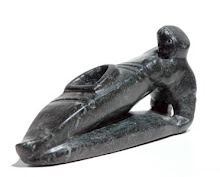 A much welcome stint of paddling interrupted for a while the building (I've already returned to it, however, and there's some progress. Ribs and keel stringer installed. Working on the chine stringers. Updates soon).
A much welcome stint of paddling interrupted for a while the building (I've already returned to it, however, and there's some progress. Ribs and keel stringer installed. Working on the chine stringers. Updates soon).I went to Gijón, northern coast, to paddle with Xabier (whose beautiful S&G Night Heron accompanies my own Fun Run Sedna in the pic above) and a bunch of other local paddlers. They are forming a sea kayak association (AKDMA, Asociación Kayak de Mar Asturias) somewhat after the example of the neighboring and successful AGKM and ACKM in Galicia and Cantabria, respectively. By the way, a sizeable group of Cantabrian paddlers showed up as well.
Saturday afternoon, however, Xabier and I were on our own. Conditions were interesting. Close to 3 m of steep (7 s period) waves and NE F4-5 winds. We briefly tested the situation out in Gijón Bay and promptly turned back to El Arbeyal, our very protected launch beach for a bit of surfing (rarely possible there). Fun time and some nice rides (mostly Xabier's) that ended up with my swimming when a successful roll after a capsize righted me just in a time for a second wave to play with me. Proof (not that it was needed) that solid back sculling can be very useful and is not just a trick to impress onlookers.
Sunday morning, the air was definitely colder (snow later in the day) and things at sea were, if anything, slightly more interesting. The videos should give an idea, though, as always, it now looks tamer on them than it did when in the middle of it.
We started on the intended route, nonetheless, with sea and wind from the bow. That I found quite manageable, but I worried about a substantial return leg with those same conditions as following, or rear quartering seas, which I always find far less comfortable. Therefore, when after a brief while a small group proposed turning back, I adhered with an inner sigh of relief.
Back at El Arbeyal, it was some more surfing and a bit of rolling and it was fun. Added to the paddling was the time spent with Xabier and his family around Gijón enjoying talk, food and cider. All in all, a great weekend.
Note: As usual, pics and vids not mine. They are here courtesy of Edu, a Cantabrian fellow paddler.


















































